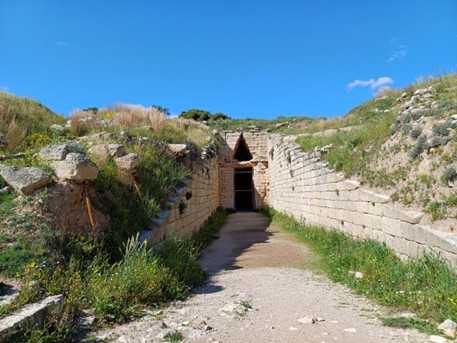By Esmée Corporaal, RMA Student in Archaeology at the University of Groningen
During the fall of 2021 when I started my research master’s, I was already encouraged to think about a potential topic for my thesis. I remember thinking about going to Greece to study Greek archaeology as this has been an interest of mine since high school. Later that year, I would take an introductory course in human osteoarchaeology. In my bachelor and RMA studies in archaeology at the University of Groningen, the themes of ancient Greek life experiences and culture as well as mortuary archaeology have been a reoccurring theme. That is why I decided to dedicated the 30 credits of my RMA thesis to researching the human remains of an ancient Greek cemetery.
For my thesis I am studying fourteen burials from the Archaic burials of the cemetery of Thebes, Boeotia. I am looking into the living conditions and variation in burial practices in Thebes and in the Archaic period of Greece in a broader sense. I am conducting the study of human remains in the Fitch Laboratory of the British School at Athens. In the first week of my stay I travelled back and forth to Thebes to gather the remains from the storage facilities of the archaeological museum. Then I moved my material to the Fitch laboratory on Friday. On Monday I started washing bones and after they dried I started examining the first burial.

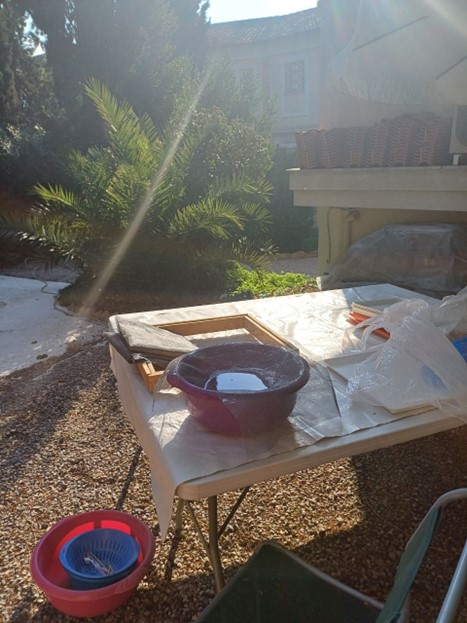
The library of the British School is a nice place to work on writing the remaining chapters of my thesis. The library cat Henry welcomes you at the door if you enter from the main entrance and is the highlight of my days at the library! You can find many books here and it always nice and quiet. During lunch breaks I can eat some salad and drink some take-away coffee from Marasli on the terrace in the sun.
Kaisariani
Besides studying bones and working on my thesis during the week, in the weekends I can make time for some nice trips because the NIA is located in the perfect spot for this! For my first excursion, I went together with someone else who stayed at the NIA to explore the forests around Athens! We first took the bus and then had to walk for another half an hour to the beautiful monastery of Kaisariani. It is an archaeological maintained monastery built in the 11th century AD. Now there is also a beautiful botanical garden, which unfortunately was closed, but we enjoyed the company of a very sweet cat! This monastery resident kept following us around and demanding pets. The monastery still has a church with beautiful paintings from the 18th century. Then we climbed Mount Ymmitos to the viewpoint. From the little tower, we could see all of Athens lying beneath us. Besides the beautiful views, it was so nice to get some fresh air outside the city. There are still a few more of these beautiful mountains, and I would also like to explore those!
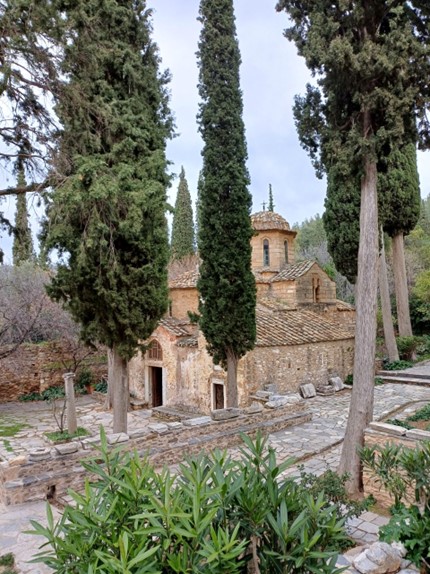
Mycenae
For my second trip, I visited Mycenae. Mycenae is a beautiful archaeological site of a city from the Greek Bronze Age with remarkable royal tombs containing stunning finds. According to legend, the infamous King Agamemnon and his wife Clytemnestra, as well as her lover Aegisthus, are buried here. The story goes that Agamemnon supported his brother Menelaus in his war with the Trojans. This was because the Trojan prince Paris had taken Menelaus’ wife to Troy (on the coast of Turkey). Unfortunately, Agamemnon had angered the goddess Artemis by killing her deer during the hunt, causing a calm before the wind when they wanted to depart for Troy. To appease the goddess, Agamemnon therefore sacrificed his firstborn daughter, Iphigenia, to her, much to the fury of his wife Clytemnestra. Agamemnon departed, and after 10 years of warfare, he would return home to Mycenae, where his wife and her lover Aegisthus had plotted revenge. They murdered him with an axe in the bath. Orestes, the only son, at the urging of his sister Electra, killed his mother and her lover as revenge for their father. The site of the city of Mycenae has always been known because the Lion Gate was always visible. Strangely enough, the tombs were never plundered by grave robbers, a phenomenon that archaeologists are unfortunately very familiar with. In addition to the beautiful archaeological site, the surroundings are also very impressive. It is amazing to see the archaeological sites that I learnt so much about in real life for the first time!
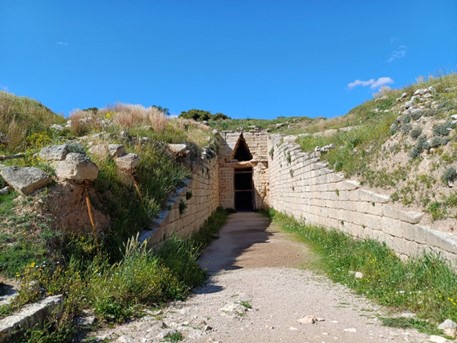
Aegina
I also took a trip to Aegina with my partner. It is a beautiful island off the coast of Athens just a half-hour boat ride from Piraeus. We arrived at the stunning harbour with azure blue sea. Upon arrival, we enjoyed a delicious meal along the promenade. Then we decided to take a leisurely walk along the coast towards the archaeological site of Kolonna (named after the only column still standing), where remains of houses, temples, and cisterns dating from prehistory to the Byzantine period lie. There is so much history here on this beautiful island! We didn’t even have time to visit the temple of Aphaia. Afterward, we decided to relax under the cliff at Kolonna and enjoyed the beautiful view and the cool seawater. Once we cooled off, we explored the village with its nice shops. Around 6 o’clock, we took the boat back to Piraeus. Unfortunately, we didn’t see any dolphins, but it was a wonderful trip!
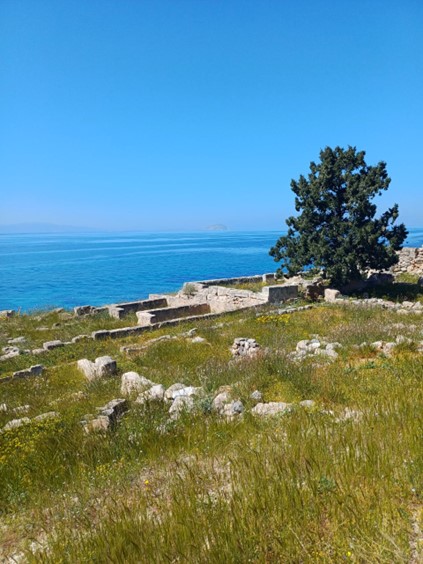
Thank you!
My gratitude goes out to Dr. Anna Moles, Dr. Efthymia Nikita, Anna Karligkioti and Prof. Sofia Voutsaki for their help with developing my plan for this research and putting me in contact with the Ephorate of Antiquities of Boeotia as well as the Archaeological Museum of Thebes. I also want to thank Dr. Vassilis Aravantinos and Prof. Margherita Bonanno Aravantinos who are the excavators of the site and granted me permission to study the human remains from Thebes for my RMA thesis. Moreover, I want to thank Dr. Alexandra Charami, Evi Tsota and Sofia Perlepe for their help at the ephorate and granting me the permission to study the material in Athens. I also want to thank the Fitch laboratory and the British School at Athens for housing me so I can study the material. Lastly, I of course want to thank the Netherlands Institute at Athens for granting me the scholarship without which I could have never had this amazing opportunity to research a topic I am passionate about in Athens
